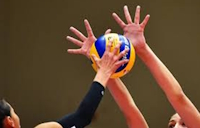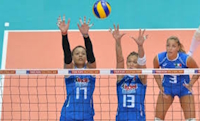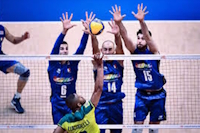Blocking is the main defensive action of players at the net to stop or alter an opponent's attack.
Blocking can also be offensive, aiming to completely stop the attack and keep the ball in the opponent's court.
A well-executed offensive block involves jumping and stretching to go over the net with the arms, sticking them out into the opponent's area. It therefore requires anticipating the direction of the ball in attack.
Blocking is part of the fundamentals of the phases of:
- Break point
- Transition
The block is classified according to the number of players involved. It can therefore be called a single, double or triple block.
 Single block Single block |
 Double block Double block |
 Muro triplo Muro triplo |
The block is a fundamental that does not present particular technical differentiation, but the needs of the game indicate functional situational adaptation strategies used by the players
- Movement techniques (basic techniques)
- Rebound plane adaptation and orientation techniques (basic techniques)
- Techniques in the various net areas (situational specialist techniques)
Blocking and defence
The block is not always effective. Furthermore, it is sometimes circumvented with attack systems other than the spike (e.g. lob!).
However, a block that forces the attacker to use different strategies is still very useful.
The position of the block influences the positions in which the other defenders are placed, while the opposing servers spike.
Let's start with what we can define as the fundamental objectives of the block; namely:
- Inhibit some trajectories
- Cushion others
- Give precise references to the defenders
- Avoid giving references to the opposing attacker
These points will reach the greatest effectiveness, the better the execution technique. To be able to perform an effective blocking action, it is not essential to be very tall or jump a lot; that is, it is not the height of the wall that determines its success, but a set of other qualities that involve:
- time
- space
In particular, the evaluation of the most appropriate jump time will be related to the type of construction chosen by the opponent and will determine the precise times of the translocations and jumps!
- The ability to correctly position the rebound plane
- The ability not to give references to the opposing attacker
will be related to the "space" that the wall will have to take.









